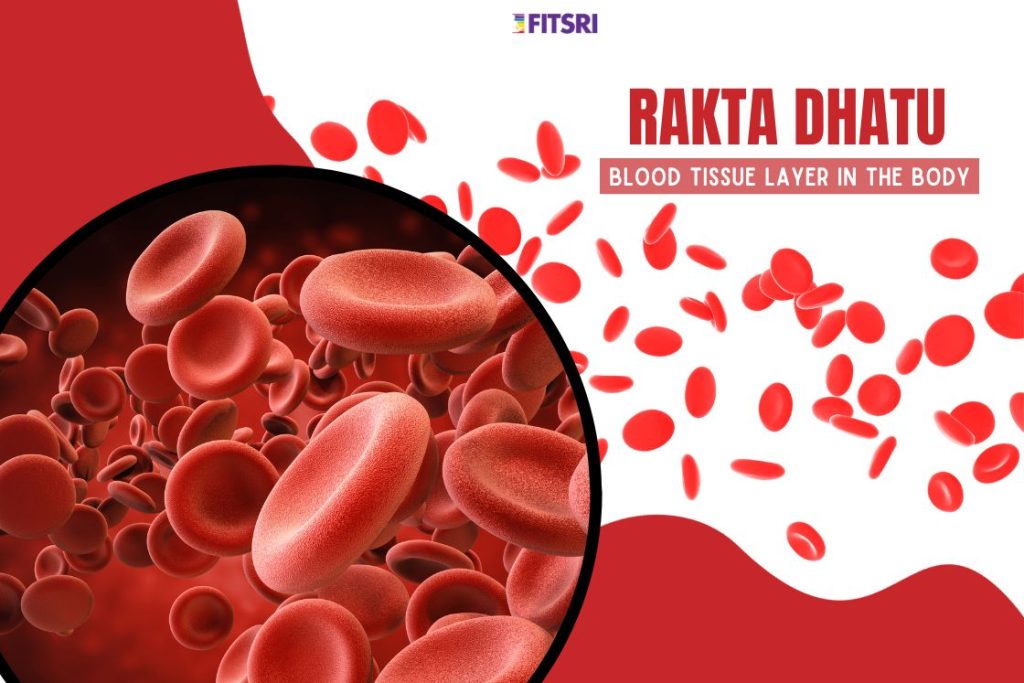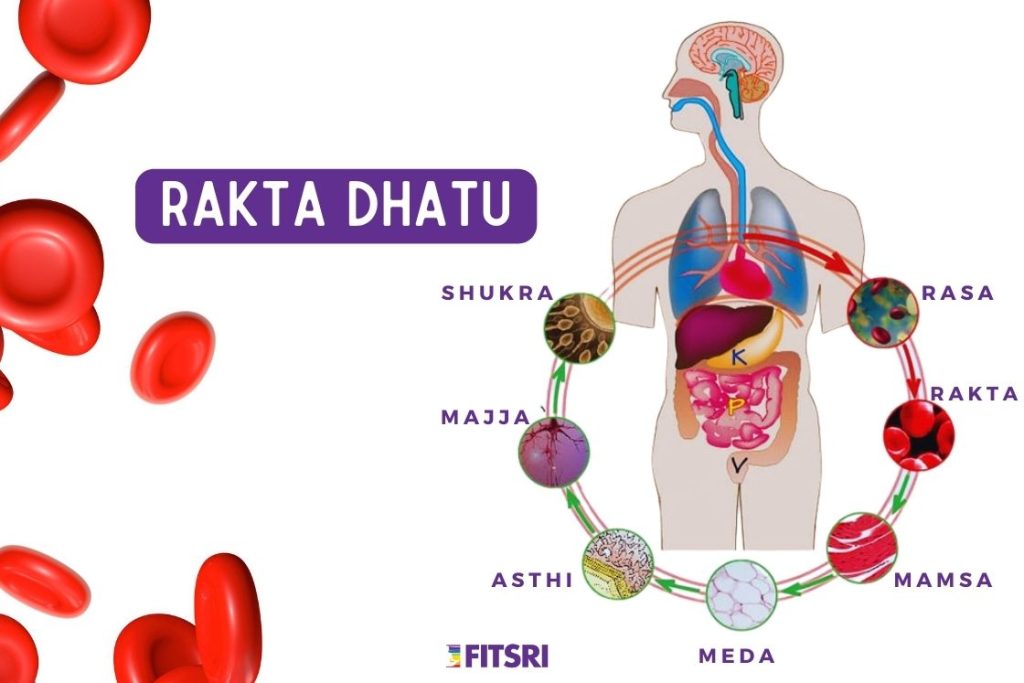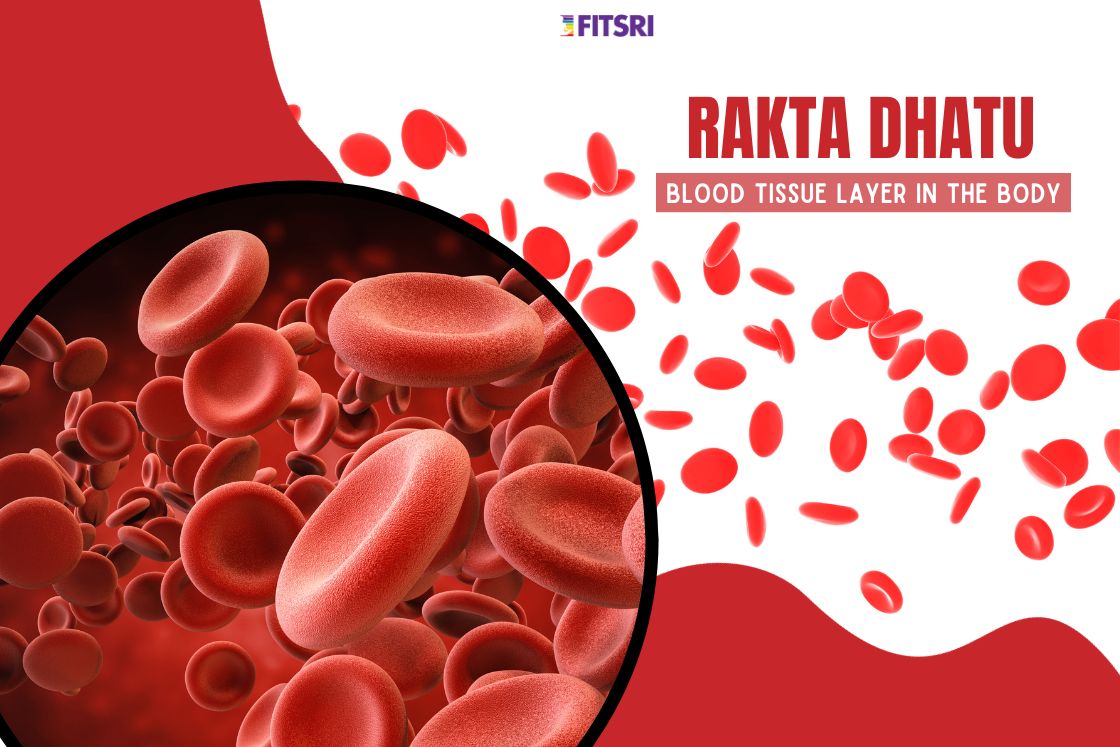
Dhatus in Ayurveda represents for the first tissues that type the constructing blocks of our physique. They not solely present construction, but additionally carry out the important physiological features that hold us alive and wholesome. When immersed within the essence of Ayurveda, the examine of the Dhatus turns into important. They supply steady nourishment, development and restore of the physique and type the inspiration upon which our holistic well being stands.
There are Seven Major Dhatus in Ayurveda:
- Rasa (Plasma)
- Rakta (Blood)
- Mamsa (Muscle)
- Meda (Fats)
- Asthi (Bone)
- Majja (Bone marrow and nervous tissue)
- Shukra (Reproductive tissue)
Within the gentle of contemporary science, one can discover fascinating parallels between the Dhatus in Ayurveda and at this time’s understanding of human physiology. For instance, when Ayurveda speaks of the “Rakta” Dhatu, it refers back to the blood tissue that trendy medication recognises as accountable for transporting vitamins and oxygen. Equally, the “Mamsa” Dhatu corresponds to our muscle groups, that are important for motion and stability.
There’s a fascinating concord on the interface between historic Ayurvedic ideas and trendy medical data. Though terminologies and strategies differ, each approaches intention to grasp the intricacies of the human physique. The Dhatus in Ayurveda, with their profound which means, may be seen as early intuitive insights into what up to date science describes in detailed physiological phrases.

At its core, Rakta Dhatu is the Sanskrit time period for the blood tissue of the physique. Rakta” interprets to “purple” or “blood”,” and “Dhatu” means “tissue” or “that which helps” Rakta Dhatu thus represents the essence of our blood tissue, which circulates all through the physique and performs a vital position in nourishing cells, transporting important vitamins, and selling total vitality.
In Ayurveda, nevertheless, Rakta dhatu isn’t just concerning the bodily blood that flows by our veins. It’s a extra holistic idea. In Ayurvedic philosophy, Rakta Dhatu ranks second among the many seven main tissues (Dhatus) in our physique, indicating its position in absorbing vitamins from the primary tissue after which nourishing subsequent tissues.
Additionally Learn: Rasa Dhatu: First Tissue Layer in Ayurveda
Wanting on the Blood Tissue Via the Scope of Ayurveda
Whereas trendy science sees blood primarily within the context of circulation and the transport of oxygen and vitamins, Ayurveda views the Dakta dhatu as a extra elementary life power that has duties past mere circulation.
Whereas blood merely refers back to the physiological parts like RBC, WBC, Platelets, and so forth, Rakta Dhatu in Ayurveda extends to parts accountable for interactions between blood, the lymphatic system, and the endocrine system.
Whereas trendy sciences contemplate immunity, temperature regulation, and waste elimination as methods separate from the circulatory (or blood) system, Ayurveda sees the essential models of immunity, temperature regulation, and toxin elimination as parts of Rakta Dhatu. Briefly, Rakta Dhatu in Ayurveda is a wider and extra inclusive class in comparison with the fashionable understanding of blood.
Furthermore, Ayurveda doesn’t separate physiology from its energetic capability as trendy science does. For instance, trendy science defines the physiology of a molecule independently of the vitality that modifications its state. Vitality is vitality, a separate power that should be studied and investigated, and that acts on physiology to result in change.
In Ayurveda, nevertheless, physiology and vitality are intertwined, as if collectively they type a single useful unit. Thus, in Ayurveda, the dhatus should not solely the physiological tissues, but additionally the energies related to these tissues.
It’s honest to level out that there isn’t a proper or flawed between Ayurveda and trendy science. Each use an analogous, but uniquely totally different systematic method to categorize the identical organic actuality of our our bodies.
What did Sushruta and Chakrapani Say About Rakta Dhatu?
The knowledge of Ayurveda and its holistic therapeutic methods has been formed and enriched by quite a few sages and students over the centuries. Two such monumental figures are Sushruta and Chakrapani. Their insights into Rakta Dhatu in Ayurveda present a deep understanding that’s nonetheless related.
Sushruta’s Perspective on Rakta Dhatu:
Sushruta described intimately the physiology, properties and features of Rakta Dhatu in his seminal work “Sushruta Samhita”. He described it as a main life-sustaining power intently associated to prana (life power). Sushruta highlighted the next factors:
- Formation: He described the method of its formation from the essence of the meals we devour, with the liver and spleen as the first websites for its manufacturing and storage.
- Qualities: Rakta Dhatu, as described by Sushruta, possesses attributes like heat and redness. It’s this heat that helps preserve the physique’s inner temperature.
- Features: Past transportation, he acknowledged its position in offering nourishment, sustaining life, and supporting the thoughts and consciousness. An imbalance in Rakta Dhatu might impression these very important features.
- Problems: Sushruta additionally outlined varied ailments and problems arising from the vitiation of Rakta Dhatu. As an illustration, pores and skin problems, bleeding circumstances, and irritation had been related to its imbalance.
Chakrapani’s Insights into Rakta Dhatu:
Chakrapani additional elaborated on the qualities and properties of Rakta Dhatu in Ayurveda. He described its inherent qualities and emphasised its cool, candy and fluid nature. For Chakrapani, the principle operate of Rakta dhatu was to nourish the physique, supporting life and vitality. He additionally mentioned potential ailments that may come up when Rakta Dhatu turns into contaminated and prompt therapeutic measures to revive its steadiness.
How is Rakta Dhatu Shaped in Our Physique?
- Preliminary Digestion and Nutrient Extraction: The meals we devour is damaged down in our digestive system, by Agni the digestive fireplace. From this digestion, a nutritive essence known as “Ahara Rasa” is derived.
- Transformation into Rasa Dhatu: The primary product of the ingested meals’s digestion is “Rasa Dhatu,” akin to plasma in trendy phrases. This nutrient-rich element varieties the baseline for subsequent tissue formations. This essence serves as the inspiration for Rakta Dhatu formation, illustrating the direct hyperlink between the standard of our meals consumption and the vitality of Rakta Dhatu in Ayurveda.
- Rakta Dhatu Emergence: Rasa Dhatu, beneath the affect of the “Ranjaka Pitta“ (a selected organic fireplace or vitality), undergoes a change within the liver and spleen. This metamorphosis ends in the formation of Rakta Dhatu. The significance of the liver and spleen on this course of is emphasised each in Ayurveda and trendy physiology, marking a major correlation.
- 5-Day Cycle: Based on Ayurvedic texts, from the ingestion of meals to the formation of refined Rakta Dhatu, it takes a span of 5 days. This timeline underscores the methodical and gradual transformation course of.
- Hyperlink with Trendy Understanding: After we study Rakta Dhatu in Ayurveda, its formation may be paralleled with the manufacturing and maturation of blood cells in trendy hematopoiesis. Each acknowledge the important position of diet and a collection of organic processes in guaranteeing the vitality of blood.
By greedy the nuances of Rakta Dhatu’s formation, we admire the emphasis Rakta Dhatu in Ayurveda locations on diet, digestion, and the interconnectedness of bodily processes. Ayurvedic methods not solely spotlight the physique’s profound skill to regenerate and maintain but additionally underscore the vitality of each dietary selection we make.
What’s Rakta Dhatu Made Up of?
The composition of Rakta Dhatu based on Ayurvedic understanding may be damaged down by the next categorizations:
- Important Nature: Rakta Dhatu is primarily related to the aspect of fireside, albeit in a balanced and nourishing type. This affiliation is indicative of its very important roles – distributing warmth, supporting metabolism, and carrying oxygen.
- Major Elements: The first constituents of Rakta Dhatu in Ayurveda are the purple blood cells. These cells are accountable for oxygen transport, which aligns with trendy medication’s understanding of the purple blood cells’ position in carrying oxygen to varied elements of the physique.
- Supportive Parts: Whereas the purple blood cells are the first element, Rakta Dhatu additionally encompasses different parts that help its main operate. These may embody vitamins, hormones, and enzymes. Collectively, they make sure the vitality and nourishment of the physique’s tissues.
- Relation to Doshas: Rakta Dhatu is intently associated to the Pitta Dosha, the bio-energy governing metabolism, warmth, and transformation. An imbalance in Rakta can usually be traced again to a Pitta imbalance, resulting in circumstances corresponding to irritation or pores and skin points.
What are the Qualities of Rakta Dhatu?
Compiling the varied references throughout the Ayurvedic literature, Rakta Dhatu may be understood to have the next qualities beneath the Ayurvedic framework:
- Sasneha (Barely Oily): One of many intrinsic qualities of Rakta Dhatu is being barely oily. This attribute ensures easy circulation and lubrication throughout the physique’s channels, facilitating seamless transportation of vitamins and oxygen to varied tissues.
- Ushna (Heat): Rakta Dhatu possesses a heat high quality. This heat is important for metabolic processes, aiding within the digestion of meals and sustaining the physique’s inner temperature.
- Drava (Liquid) and Sara (Fluid): Being liquid and fluid are elementary to Rakta Dhatu’s nature. These states enable it to stream by the circulatory system, guaranteeing each cell will get the vitamins it wants.
- Laghu (Gentle): Rakta Dhatu is gentle, which suggests it may well flow into swiftly, guaranteeing well timed supply of vitamins and elimination of waste merchandise.
- Visra (Foul Smelling): When Rakta Dhatu is imbalanced or vitiated, it may well develop a foul scent. This high quality is a diagnostic software in Ayurveda, indicating potential points or imbalances throughout the physique.
The Ayurvedic Relation Between Rakta and Agni
Ayurveda usually employs nature-derived ideas to elucidate its ideas. One such foundational notion is the correlation between blood and fireplace. This relationship underscores the pivotal position of Rakta Dhatu in Ayurveda in sustaining steadiness and guaranteeing the physique’s vitality.
- Fireplace as a Transformative Power: In Ayurveda, fireplace symbolizes transformation and alter. It’s not simply concerning the literal flame; it’s the essence that drives change. Trendy sciences echo this concept, defining vitality because the capability to instigate change, whether or not it’s shifting an object or facilitating a chemical response inside our cells.
- Introduction to Biologic Fireplace: Transferring from the exterior world to the intricate processes inside our our bodies, we encounter the idea of organic fireplace. This isn’t the hearth you see, however the transformative vitality or “Agni” in Ayurveda. It’s the power that powers our metabolic reactions, breaks down meals, and generates heat.
- Biologic Fireplace and Rakta Metabolism: Rakta Dhatu, our main focus, performs an integral position on this transformative course of. The metabolism of Rakta Dhatu in Ayurveda is pushed by a selected organic fireplace generally known as “Ranjaka Pitta.” Located within the liver and spleen, Ranjaka Pitta oversees the conversion of nutrient essence from digested meals into mature Rakta Dhatu.
- Rakta’s Function in Sustaining Physique’s Fireplace: As soon as Rakta Dhatu is fashioned and infused with this vitality, it doesn’t simply keep static. Via circulation, Rakta Dhatu distributes this fireplace or vitality, sustaining the physique’s total heat, fueling mobile actions, and guaranteeing the graceful functioning of organs. Consider it as a distributive community, guaranteeing each nook of our physique stays invigorated.
Understanding the physique’s elementary parts is vital in each Ayurveda and trendy medication. Rakta Dhatu in Ayurveda and blood in trendy medication seem to explain the identical factor. Nonetheless, delve deeper and also you’ll see the distinguished variations of their approaches.
1. The Composition of Blood Tissue
- Ayurvedic Perspective: Rakta Dhatu in Ayurveda embodies the essence of life and vitality. Though it circulates vitamins, Rakta Dhatu’s essence is deeply religious, related with the physique’s very life power. Ayurveda acknowledges Rakta to be made up of parts just like the organic fireplace, the remodeled “Rasa” and a elementary entity that attributes the colour purple. The elemental entity that contributes to the colour may be thought of because the RBC.
- Trendy Perspective: Blood, in trendy science, is a tangible fluid comprised of purple and white blood cells, platelets, and plasma. Its parts have particular duties, from oxygen transport (due to hemoglobin in purple blood cells) to immune protection (attributed to white blood cells).
2. Formation
- Ayurvedic Perspective: The formation of Rakta Dhatu is an interesting course of rooted within the physique’s digestive operate. After we devour meals, it’s remodeled right into a juice known as “Ahara Rasa.” This juice undergoes additional refinement, ensuing within the creation of every Dhatu, with Rakta Dhatu being one in every of them.
- Trendy Perspective: Blood cell formation, or hematopoiesis, happens within the bone marrow. Stem cells current right here differentiate into varied blood cells. The method is influenced by a number of components, together with sure hormones and physique wants.
3. Websites of Motion
- Ayurvedic Perspective: Rakta Dhatu in Ayurveda operates in particular bodily channels generally known as “Srotas.” These channels distribute diet and preserve varied physiological features. The liver and spleen, particularly, are very important websites for Rakta Dhatu’s actions, together with manufacturing and storage.
- Trendy Perspective: Blood operates by the cardiovascular system, comprising the guts, veins, arteries, and capillaries. This method ensures that oxygen, vitamins, and hormones attain each cell, and waste merchandise are effectively eliminated. The liver and spleen play a vital position in cleaning and sustaining the standard of the blood, however probably not the positioning of manufacturing or storage.
Within the subject of Ayurveda, the purple shade of the Rakta Dhatu is intently related to the Pitta Dosha, which is supported by the basic forces of fireside and water. On nearer examination, it’s the Ranjaka Pitta subtype of this Dosha that offers the blood its attribute purple shade. This fiery dimension of Pitta, reflecting the transformative energy of fireside, is central to the vitality and vibrancy of our blood.
Seen by the eyes of contemporary science, our blood owes its crimson shade to purple blood cells (RBCs). These cells are teeming with hemoglobin, an necessary protein that ensures oxygen travels from the lungs to each nook of our our bodies. The science behind the colour is fascinating: when hemoglobin binds oxygen, it creates oxyhemoglobin, which emits a brilliant purple glow. If, then again, this bond is damaged and the oxygen escapes, what stays is deoxyhemoglobin, which takes on a dusky, darkish purple, virtually blueish tint.
Bridging these views, Ranjaka Pitta from the “Rakta Dhatu in Ayurveda” narrative may be analogized with trendy scientific phenomena. It bears semblance to the metabolic vigor that propels hemoglobin to clinch oxygen molecules, or it’d even be perceived as a mirrored image of the character of hemoglobin itself. Via this mix of historic knowledge and up to date data, we achieve a richer, extra holistic understanding of the essence of our blood.
The idea of Rakta Dhatu is central in Ayurvedic teachings, performing as a cornerstone of our bodily well being. When this very important tissue is in steadiness, it brings forth a myriad of advantages, contributing considerably to our total well-being. So, how precisely does a wholesome Rakta Dhatu affect our state of well being? Let’s discover:
- Vigorous Circulation: A wholesome Rakta Dhatu ensures environment friendly circulation all through the physique. This implies oxygen and important vitamins are delivered successfully to each cell, fostering vitality and vitality. It’s like having a well-oiled machine, the place each half features optimally.
- Toxin-free Physique: Rakta Dhatu in Ayurveda performs a pivotal position in detoxing. When wholesome, it effectively transports waste merchandise away from cells, resulting in a physique that’s purged of poisons. The end result? Enhanced physique features and a decreased threat of ailments.
- Sturdy Immunity: A balanced Rakta Dhatu is akin to a protect. It fortifies our immune system, making us proof against infections and diseases. When our protection mechanism is robust, we will fend off exterior invaders with ease, guaranteeing longer, more healthy lives.
- Psychological Readability: Rakta Dhatu doesn’t solely profit our bodily state. Enough oxygen and nutrient provide, courtesy of a wholesome Rakta Dhatu, result in higher mind operate. This interprets to clearer thought processes, improved focus, and enhanced cognitive skills.
- Harmonious Stability: Rakta Dhatu in Ayurveda can be about sustaining equilibrium. A wholesome Rakta Dhatu helps different tissues, guaranteeing a harmonious steadiness of all bodily features. This interconnectedness paves the best way for a state of complete well-being.
Figuring out the Signs of Unhealthy Rakta Dhatu: Indicators of Visuddha Raktawan Purusha
The concord of our physique, as elucidated within the ideas of Rakta Dhatu in Ayurveda, may be disrupted when this important tissue turns into impure or unhealthy. This situation is termed as “Visuddha Raktawan Purusha” in Ayurvedic terminology. Recognizing the signs related to unhealthy Rakta Dhatu is essential for well timed intervention and restoration of steadiness. So, what are these indicators that one ought to be alert about?
- Pores and skin Abnormalities: The primary tell-tale signal of impure Rakta Dhatu is clear on the pores and skin. Circumstances corresponding to pimples, rashes, eczema, or an unnatural pallor can counsel that every one isn’t properly with the Rakta Dhatu.
- Inflammatory Problems: Unhealthy Rakta Dhatu can set off inflammatory responses within the physique. This will manifest as joint pains, swelling, or redness in varied physique elements.
- Blood Problems: Folks with compromised Rakta Dhatu could also be vulnerable to blood problems. Anemia, clotting points, and different associated circumstances can come up as a result of imbalance of this tissue.
- Weak Immunity: Falling sick often? This might point out an unhealthy Rakta Dhatu. A weakened immune response, frequent infections, or extended restoration intervals sign an underlying situation with this very important tissue.
- Emotional Instabilities: The connection between Rakta Dhatu in Ayurveda and our emotional well-being is profound. Temper swings, irritability, and unexplained bouts of anger may be tied again to a compromised Rakta Dhatu.
- Extreme Warmth: Feeling unusually heat, experiencing extreme thirst, or having burning sensations may also be attributed to impurities within the Rakta Dhatu.
- Imaginative and prescient Issues: Unhealthy Rakta Dhatu can impression our eyes, resulting in signs corresponding to bloodshot eyes, blurred imaginative and prescient, and even night time blindness.
Listed below are ten holistic suggestions, encompassing yogic weight loss plan, yogic practices, and extra, that can assist you obtain this.
- Balanced Weight loss program: Consuming a weight loss plan wealthy in iron and different important minerals can fortify the blood. Incorporate leafy greens, beetroot, pomegranate, and legumes, which naturally purify and strengthen Rakta Dhatu.
- Keep Hydrated: Consuming ample water aids in flushing out toxins from the bloodstream. Intention for at the very least 8 glasses of water each day to keep up blood purity.
- Pranayama: Correctly implementing conscious respiration could make a world of distinction. Respiratory workout routines like Anulom Vilom and Kapalbhati can improve oxygen ranges within the blood. Additionally they assist in decreasing stress and calming the thoughts, guaranteeing a harmonious Rakta Dhatu.
- Yoga Asanas: Incorporate poses like Dhanurasana (Bow Pose) and Sarvangasana (Shoulder Stand) in your routine. These asanas help in bettering blood circulation and purifying Rakta Dhatu.
- Restrict Processed Meals: Rakta Dhatu in Ayurveda emphasizes the importance of pure meals. Processed meals with components can contaminate the blood, so it’s greatest to attenuate their consumption.
- Keep away from Overexposure to Solar: Extended solar publicity can improve the Pitta dosha, probably affecting the purity of Rakta Dhatu. Use protecting measures like hats or umbrellas when open air.
- Cleansing: Frequently detoxify your system utilizing Ayurvedic therapies corresponding to Panchakarma, and yogic cleaning kriyas which help in eradicating impurities from the physique, guaranteeing a pure Rakta Dhatu.
- Meditation: Stress and damaging feelings can have an effect on the integrity of Rakta Dhatu. Incorporate each day meditation to keep up emotional steadiness and make sure the well-being of the blood.
- Restrict Alcohol and Tobacco: Extreme alcohol and tobacco consumption can introduce toxins into the bloodstream. Moderation or full avoidance can help in sustaining the purity of Rakta Dhatu.
Conclusion
On the best way to grasp the significance of Rakta Dhatu in Ayurveda, we notice its very important position in sustaining life, nourishing the physique and sustaining well being. Rakta Dhatu is extra than simply blood; it’s a dwelling illustration of our vitality, offering important vitamins and oxygen to each cell and organ.
For these searching for to steadiness and purify their Rakta Dhatu, yoga emerges as a potent software. Every asana, every breath, is a step nearer to optimum well being and well-being.
Yoga promotes higher blood circulation and ensures that Rakta Dhatu flows seamlessly, offering vitamins to each a part of the physique. Respiratory strategies in yoga, corresponding to Pranayama, promote the environment friendly consumption of oxygen, which in Ayurveda is important to the well being of Rakta Dhatu. Past the bodily facet, yoga helps cut back stress, which not directly advantages the standard and performance of Rakta Dhatu.
Principally, yoga isn’t just an train for the physique, however a rejuvenation for our Rakta Dhatu. It integrates the traditional knowledge of Rakta dhatu in Ayurveda with sensible, accessible strategies that profit us within the trendy world.
So after we go away the mat and exit into the world, we should always carry consciousness of the priceless treasure inside us – our Rakta Dhatu. By combining yoga and the ideas of Rakta Dhatu in Ayurveda, we maintain the important thing to a lifetime of steadiness, vitality and holistic well-being.



